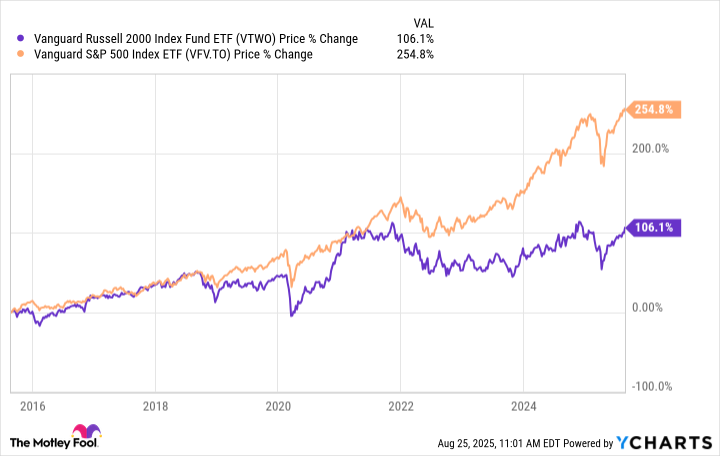Over the past decade, small-cap stocks have wildly underperformed large caps in the broader benchmark S&P 500. Much of this can be attributed to the boom in technology and artificial intelligence, which has swelled a small group of stocks in the S&P 500 to dizzying, trillion-dollar-plus market capitalizations, far beyond what most could have imagined.
But once upon a time -- and perhaps still today -- many investors believed that the highest alpha could be generated by investing in under-the-radar stocks that didn't make the headlines. With small caps recently gaining some momentum, is now the time to buy the Vanguard Russell 2000 Index ETF (VTWO +0.86%)?
Small caps finally get a lift
The Russell 2000 is the best-known index for small-cap stocks, with market caps ranging from $250 million to $2 billion. Small-cap companies are less developed but offer higher potential growth rates. The downside is that their balance sheets are typically weaker and more leveraged, which makes them more vulnerable to the economic cycle. Here are the returns from the Vanguard Russell 2000 compared to the S&P 500 over the past decade.
Small caps tend to perform better in a lower interest rate environment, which tends to stimulate the economy. In this environment, companies carrying floating-rate debt enjoy cheaper interest on that debt, bolstering their balance sheets.
Additionally, the discount rate used in many discounted cash-flow models to value stocks is typically the 10-year U.S. Treasury note or a U.S. Treasury bond with a different duration. So, when the discount rate falls, valuations rise. Investors are also forced to take more risks in a falling-rate environment because Treasuries and other safer investments, such as certificates of deposit, don't pay out as much.
Since 2022, the U.S. has been dealing with some of the highest interest rates since 2008, as the Federal Reserve had to move quickly once it got caught behind the eight ball in regards to inflation. This has proved to be a headwind for small-cap stocks in the Russell 2000.
But at the Fed's recent Jackson Hole Symposium, Fed Chair Jerome Powell hinted at a potential adjustment to the Fed's policy stance. Many interpreted this to mean that the Fed would resume interest rate cuts at its upcoming September meeting. The Russell 2000 absolutely ripped immediately following Powell's speech, rising 4% that day.

Image source: Getty Images.
The market sees a high probability of the Fed cutting rates in September and expects five rate cuts between now and the end of 2026. That should serve as a tailwind to small-cap stocks, unless the economy takes a sudden turn for the worse and finds itself in some kind of severe recession.
Is the Vanguard Russell 2000 Index Fund ETF a buy now?
As of Aug. 25, the Russell 2000 traded at about 18.5 times forward earnings, which is toward the highs experienced in recent years and above its 10-year rolling average. However, it's quite possible that earnings revisions have not come in to reflect the Fed's dovish stance, which would bring the forward earnings multiple down.
Ultimately, if you have a longer investing time frame, I do think you should allocate at least some capital to the Russell 2000 or associated small caps. They have underperformed significantly over the past decade, and if the Fed lowers interest rates and there is a broadening of depth in the market, this group is likely to benefit. Given excessive concentration in the S&P 500, I do not think you want to be as concentrated in the broader benchmark index as normal.
Smaller-cap names are riskier than blue chip stocks but offer long-term growth potential that can help investors achieve the necessary returns to properly grow a modern, long-term-oriented portfolio.

